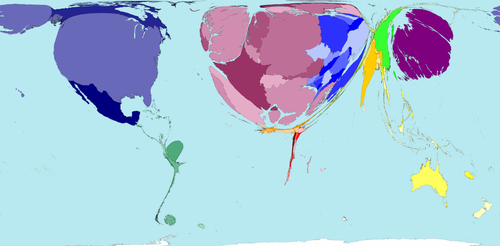Wastewater treatment
Connection of household to sewers
Image Credit: Sasi Group (University of Sheffield) and Mark Newman (University of Michigan), 2006 http://www.worldmapper.org/display.php?selected=185
Next to water source protections, e.g. by riparian river buffers, forest protection, etc., another major role of water resource protection is the implementation of proper water treatment plans.
Worldwide only a small percentage of households are connected to sewer and treatment plants. Whereas Europe and USA reaches more than 90 % the other continents are far below 40 % or even 20 %.
The situation is even worse in rural areas. Here, sewers and water treatment plants as well as waste water connection systems are almost nowhere in place and most common toilets are PIT latrines which effectively pollute shallow groundwater.
Waste water treatment plants are cost effective and require skilled personnel for operation. A wide variety of treatment plants exist worldwide, but the processes for treatment rather similar. However waste water treatment plants are – due to operational costs – usually established in or nearby cities and towns but rare in rural areas.
The focus of IWM is more on rural areas than on urban and therefore other management options for water treatment must be considered:
- small scale biological treatment
- holistic sanitation management, such as eco sanitation

Waste water treatment process (Image credit: Josefpm, 2006, http://en.wikipedia.org/wiki/File:ESQUEMPEQUE-EN.jpg)



